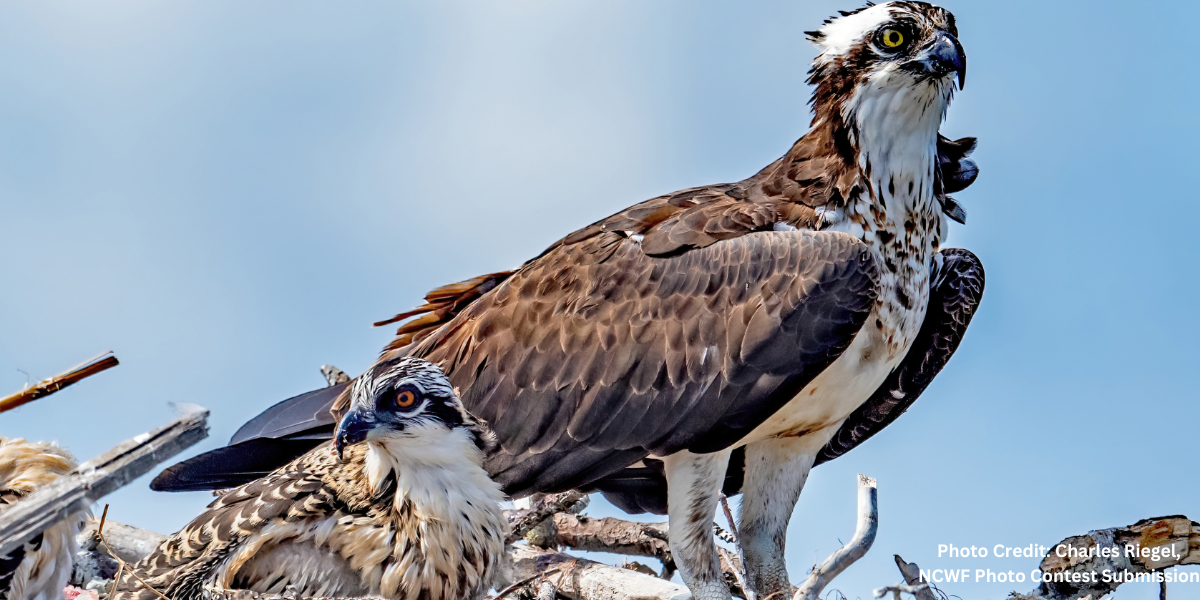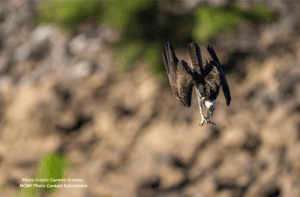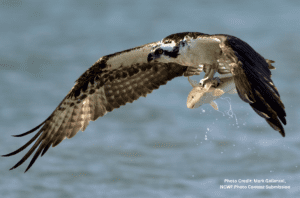A Bird’s Eye View – Catch a Live View of Lake Norman’s Famous Ospreys

Birds of prey – including ospreys – have a special power to catch the eye and interest of all who have the chance to spot them. Their graceful soaring, watchful gaze, and lethal hunting prowess strike fear into their prey… while simultaneously holding us in awe.
But nesting at the very tops of trees and soaring far overhead often keeps these species at a distance, with few opportunities to appreciate them up close. What if we could have a close-up view, showcasing a day in the life of these species?
Fortunately… we do!
Watch osprey live 24/7 on Lake Norman
Thanks to a live camera feed of a nesting platform on Lake Norman, you have the opportunity to watch a pair of famous ospreys as they return from their wintering grounds, lay eggs, and raise their young. While they have not arrived yet this year, we anticipate that they will return in the coming weeks.
But in the meantime… here’s a little more about this incredible species of wildlife.
What are Ospreys?

A diving osprey displaying its distinctive “M” shaped flight style
A staple of North Carolina waterways, ospreys can be sighted across the state wherever there are large bodies of water, such as lakes, ponds, rivers, and coastal waters.
Recognizable for their large nests built at the top of large trees or nesting platforms, ospreys are also identified by their characteristic flight style, with their wings folded into an “M” shape.
Ospreys are large birds and have a wingspan of up to 6 feet. As a bird of prey living near bodies of water, their primary food source is fish. Whereas some species of raptor skim the surface and grab fish, ospreys are the only raptor to plunge straight into water to catch their prey.
Osprey (Pandion haliaetus) are prevalent along the 225-mile long Catawba River running from western NC down into South Carolina, but this wasn’t always the case. As late as the early 1980s, osprey populations on the Catawba River, like in many places, were non-existent or minimal at best. This was due to environmental factors, most notably widespread usage of the pesticide DDT, which weakens eggshells. Their numbers have significantly increased through a concerted effort to re-introduce osprey populations.
Previously, osprey built nests in Lake Norman atop old navigational markers that were precarious and unsafe for eggs and chicks during heavy summer storms. Volunteers from NCWF, Lake Norman Wildlife Conservationists and Piedmont Area Wildlife Stewards replaced the markers with 30-foot poles with metal platforms attached and deployed by barge.
 The unencumbered height of the platforms is attractive to the birds while also protecting them against predators like black snakes and raccoons. Additional platforms are installed in Lake James, Mountain Island Lake, Lake Wylie and Lake Norman–all reservoirs of the Catawba River.
The unencumbered height of the platforms is attractive to the birds while also protecting them against predators like black snakes and raccoons. Additional platforms are installed in Lake James, Mountain Island Lake, Lake Wylie and Lake Norman–all reservoirs of the Catawba River.
They provide nesting sites on large open bodies of water and healthy prey options, primarily live fish. Osprey will catch fish from the water using their long, hooked talons. An osprey can plunge so forcefully into the water that it will completely submerge. When carrying their prey back to the nest, osprey will arrange the fish so it’s facing upright head forward. Occasionally, they’ll catch and eat a snake, eel or even a frog.
The thriving osprey population on Lake Norman is a testament to the effectiveness of our mission to protect, conserve and restore the wildlife and habitats of North Carolina. Nearly all the platforms support nesting ospreys year after year. The young birds fledge in the summer and often migrate to Central and South America in the fall (the females usually leave about a month before the males), and they return to their nesting sites every March.
Stay tuned for more updates on Lake Norman’s ospreys… and keep your eye on the live nesting platform feed on our website!
Written by:

– Bates Whitaker, NCWF Communications & Marketing Manager

